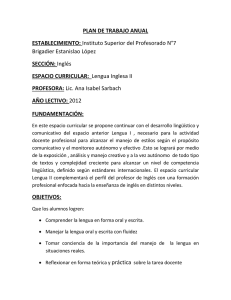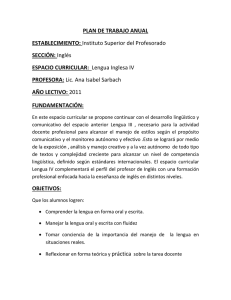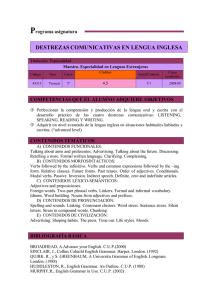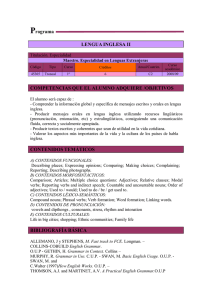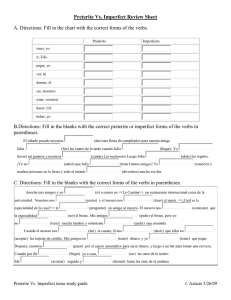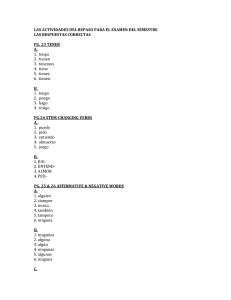Students` Basic Grammar of Spanish
Anuncio
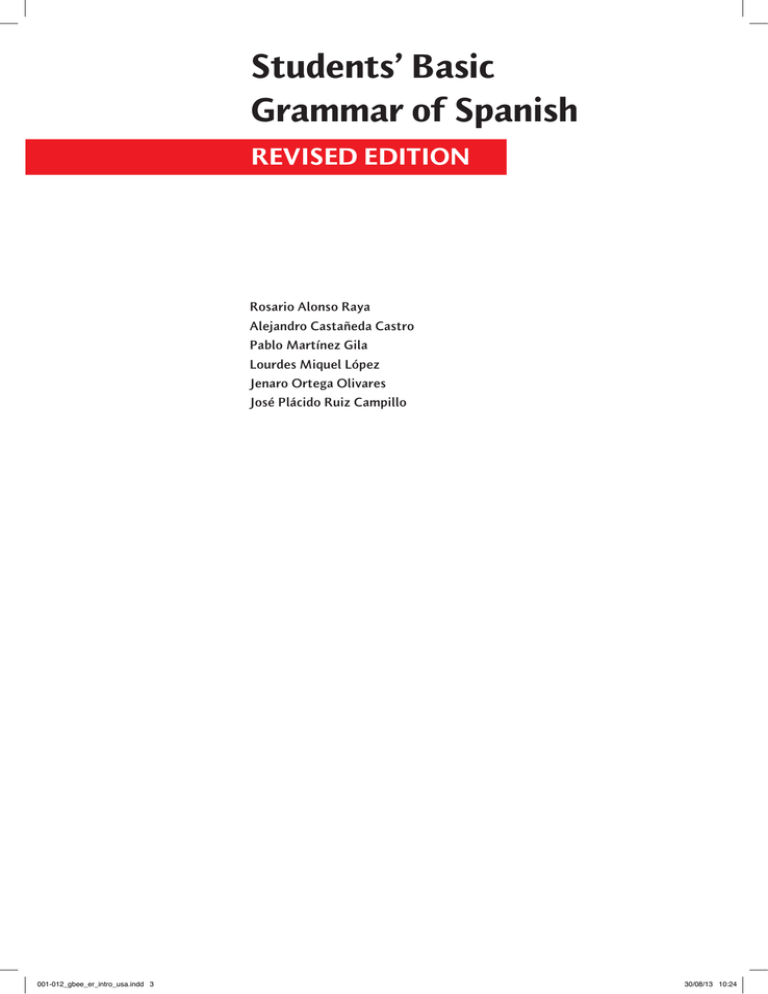
Students’ Basic Grammar of Spanish REVISED EDITION Rosario Alonso Raya Alejandro Castañeda Castro Pablo Martínez Gila Lourdes Miquel López Jenaro Ortega Olivares José Plácido Ruiz Campillo 001-012_gbee_er_intro_usa.indd 3 30/08/13 10:24 First edition: august 2009 Acknowledgements © The authors and Difusión. Centro de investigaciones y publicaciones de idiomas, S.L. c/Trafalgar, 10, entlo. 1ª 08010 Barcelona Tel. (+34) 93 268 03 00 / Fax (+34) 93 310 33 40 editorial@difusion.com www.difusion.com People who search for grammar books are looking for a map to an unknown land. They are pirates, astronauts, crazy adventurers bent on discovering an entire universe. There is Authors: Rosario Alonso Raya Alejandro Castañeda Castro Pablo Martínez Gila Lourdes Miquel López Jenaro Ortega Olivares José Plácido Ruiz Campillo Rosario Alonso, Alejandro Castañeda, Lourdes Miquel and Jenaro Ortega’s involvement in this edition is linked to the development of project number FFI2009-13107, financed by the Ministry of Science and Innovation. Coordination and design: Jordi Sadurní Ventura Editing: Paco Riera Arteaga, Jordi Sadurní i Ventura Cover design: Oscar García Ortega Educational consultant: Agustín Garmendia Documentation: Olga Mias English edition: Bob Flory, Brian Brennan Illustrations: David Revilla Photographs: Pág. 36, 102, 106, 116, 140, 146, 153, 217, 234, 237: autores y familiares. Pág. 44: 1: Rasmus Evensen, Didvision, 2: John Pring (john@johnpringphotography.com), 3: Franco Giovanella (franco@revistanossa.com.br), 4: San San (san@loungefrog.com). Pág. 110: João Estevão A. de Freitas (jefras@netmadeira.com). Pág. 193: Real Ibérico, Consorcio para la Promoción del Jamón Ibérico Español. nothing more daring nor more generous than learning a language. It is an endless undertaking, overwhelming and worthy of heroes. Like Adam in the Garden of Eden, you start to name the world afresh. If you have got this far and are hol- of us. Thank you. Thanks also to our students of the Centro de Lenguas Modernas of the University of Granada, of the Escuela ding this grammar book in your hands, you are already one Oficial de Idiomas-2 in Barcelona and of the Instituto Cervantes in Istanbul, all expedition members on the Safari of learning, for it is really they who have shown us where the sinking sands, the oases, the caves and volcanoes, the wild watercourses and the cool pools of crystal-clear waters are. For it is they who have guided and corrected the lines on this map with the lucid testimony of their grammatical adventures. For it is not they who have learned from this grammar book: it is this grammar book that has learned from them. Thank you to the inventive genius of David Revilla our artist; thank you for the support, patience and help of Agustín Garmendia and the Difusión production team, thank you for the sensitivity, involvement, understanding and enthusiasm of Jordi Sadurní. And, above all, we thank our long-suffering families and our temporarily abandoned friends for having put up with our long absences in imaginary countries. From our long stays in the region of the pronouns, in the jungle of the subjunctive, and on the planet of qué, quién, Printed by Tallers Gràfics Soler S.A. cuál or in the castle of ser and estar, we returned worse off ISBN: 978-84-8443-437-5 Legal deposit: B-25797-2013 than we had set out, more aware of the bottomless chasms and on the verge of being seduced by the dark side of the force. Adoración, Alicia, Ángela, Antonio, Arnau, Carlota, Carmen, Carmen, Francisca, Gloria, Héctor, Inma, Juani, Jesús, Any form of reproduction, distribution, public communication or transformation of this work is strictly prohibited without the consent of the intellectual property owners. Any violation of the above-mentioned rights could constitute a criminal offence against the intellectual property (Art. 270 and following of the Penal Code). 001-012_gbee_er_intro_usa.indd 4 Lucía, Lucía, Lucía, Luis, Mari, Mopa, Plácido, Puchi, Rosario, Samuel, Teo, Xavier, your contributions are priceless. The map makers 24/10/13 11:14 Index 10 Introduction 11 How the SBGS is organised section 1 Nouns and Adjectives 14 14 a General rule: el edificio, la casa… 14 b Special rules: el problema, la mano… 1. Noun. The gender of things 17 17 a General rule: doctor, doctora… 18 b Special rules for the gender of people: marido, mujer… 19 c Special rules for the gender of animals: toro, vaca… 20 20 a Forming the plural: mapa, mapas; país, países… 21 b Special cases: la gente, las gafas… 23 23 24 25 26 26 28 2. Noun. The gender of people and animals 3. Noun. Number 4. Adjective a b c d e f Gender: guapo, guapa; interesante… Number: guapos, guapas; interesantes… Concordance: Unos amigos griegos. Adjective after noun: ¿Vino tinto o vino blanco? Adjective before noun: Mi apartamento pequeño / Mi pequeño apartamento Un gran problema / Un problema grande section 2 Determiners 30 5. 30 31 33 34 36 Articles: Un, el, ø a Forms b Uses: Toma una carta / Toma la carta c ¿Un o el o ø?: Tenemos teléfono. Suena un teléfono. He roto el teléfono. d Generalising: A los españoles les gusta el café… e Uno alto, el de Soria, el que te dije… 37 6. 37 39 39 40 Demonstratives: este, ese, aquel… esto, eso, aquello… a Este libro; ese libro; aquel libro. b Uses connected with time: Este mes. Ese día. Aquel fin de semana. c Este, ese, aquel… d Neutral demonstratives: ¿Dónde pongo esto? No me digas eso. ¿Qué es aquello? 43 7. 43 45 46 47 48 49 Possessives: mi, tu, su… mío, tuyo, suyo… a Possessives before the noun: mi amigo, mi amiga… b Possessives after the noun: un amigo mío, una amiga mía… c Un amigo mío / Mi amigo d Without noun: Tu casa es bonita pero la mía es más grande. e ¿De quién es? Es nuestro: mío, tuyo y de Pepe. f Special cases:: Tengo el pelo mojado. 50 8. 50 52 53 54 Indefinite articles: todos, algunos, alguien, nada, otros… a Algún estudiante, ninguna casa, todos los días… b Alguien, nadie; algo, nada; todo. c Double negative: No hay ninguno; no hay nadie; no hay nada. d Otro, otra, otros, otras. 56 9. 56 57 58 59 59 60 Cardinal numbers: uno, dos, tres… a From 0 to 15 b From 16 to 99 c From 100 to 999 d From 1.000 to 999.999 e Millón, millones… f How to say numbers in Spanish. 001-012_gbee_er_intro_usa.indd 5 30/08/13 10:24 61 10. 61 62 62 63 Ordinal numbers: primero, segundo, tercero… a Meaning and forms b How they work c Uses d Ordinals from 10th upwards 64 11. 64 65 66 Quantifiers: demasiado, mucho, bastante… a With nouns: mucho chocolate / muchas galletas b Poco / un poco de + uncountable nouns: Hay un poco de comida pero hay poca bebida. c With adjectives, adverbs and verbs: Corre mucho; es muy rápido; está muy lejos. section 3 Personal pronouns 68 12. 68 70 70 71 13. Subject pronouns: yo, tú, él… 71 a Forms: yo, tú, él… 72 b With and without the pronoun: ¿Cómo te llamas? / ¿Tú cómo te llamas? 73 14. Pronouns with prepositions: a mí, para ti, con él… 73 a Forms 74 b Conmigo, contigo, con él… 15. 75 75 76 78 Object pronouns: me, te, nos… lo, la, le, los… a First and second person: me, te, nos, os. b Third person: lo, la, los, las / le, les. c Neutral lo: Yo eso no lo entiendo. Parece fácil, pero no lo es. 79 16. 79 80 80 81 82 83 Position and combination of object pronouns a One pronoun: Te he visto. Os he visto. b Combination of two pronouns: Te lo compro. Os lo compro. c Combination of two pronouns: Se lo compro. Se la compro. d With affirmative imperative, infinitive and gerund: déjasela, dejársela, dejándosela… e With periphrastic verbs: Tienes que comértelo / Te lo tienes que comer f In reflexive and opinion-expressing constructions: Se las lava. Le gusta el chocolate. 84 17. Presence and redoubling of pronouns 84 a Use of lo, la, los, las / le, les: Lo ha comprado. Le ha dado un regalo a María. 85 b Redoubling: Me ha mirado a mí. 87 18. 87 88 89 90 92 95 97 100 Personal pronouns. Introduction. a Subject, direct object and indirect object b Reflexive constructions: Ella se pinta. c Constructions that express opinions: A Jaime le gustan las motos. Reflexive and opinion-expressing constructions a Reflexive constructions: Me baño. Me lavo los dientes. b Uses: Te has mojado. Te has mojado el pelo. Te has mojado la blusa. c Reciprocity: Nos conocemos. Nos queremos. d Cambios de estado: El fuego se ha apagado y la comida se ha enfriado. e Ir(se), llevar(se) / venir(se), traer(se) f Verbos de ingestión: comer(se), beber(se), tomar(se) g Construcciones impersonales con se: Aquí se vive bien / Se invitó a toda la familia. h Opinion-expressing constructions: Me gusta… Les da miedo… Nos parece bien… section 4 Verbs 001-012_gbee_er_intro_usa.indd 6 104 19. 104 105 106 Conjugation. The basic building blocks. a Talking about a verb: the infinitive. b Conjugating a verb c Verb and subject concordance 107 20. 107 107 108 109 Non-personal forms: hablar, hablando, hablado. a Meaning and form of the infinitive: hablar, comer, vivir. b The infinitive as a noun c The infinitive as a verb d Meaning and form of the gerund: hablando, comiendo, viviendo. 30/08/13 10:24 110 111 112 113 e f g h 114 21. 114 115 115 116 117 118 118 119 120 Presente de indicativo a Regular verbs: hablo, como, vivo… b Verbs with vowel changes: quiero / puedo, juego… c Verbs with vowel changes: pido, repito… d First person irregular: hago, pongo, salgo… e First person irregular and other changes: tener, venir, decir, oír, estar. f Very irregular verbs: ir, ser, haber. g Uses. Present affirmations: Mi novio está en Madrid. h Uses. Future affirmations: Mi novio vuelve mañana. i Uses. General affirmations: Los hombres son así. 121 22. 121 122 124 Pretérito perfecto de indicativo a Meaning and forms: he hablado, he comido, he vivido… b The recent past: Ha llovido mucho. Este verano ha llovido mucho. c The past in the future: A las cinco he terminado. 125 23. 125 126 127 127 128 Pretérito indefinido a Meaning and forms: hablé, comí, viví… b Verbs with an irregular stem: dijo, puso, estuvo… c Verbs with vowel changes: pidió, durmió… d Dar, ir, ser. e Uses:: El viernes pasado los vi. Cuando entraba, los vi. 129 24. 129 130 132 ¿Perfecto or Indefinido? Ha salido / Salió a Present and past time periods: Este año ha sido horrible / El año pasado fue horrible b Unspecified time periods: Nunca ha pasado nada / Nunca pasó nada c Recent time periods: Ya he terminado / Ya terminé 25. 133 133 134 135 135 136 137 Pretérito imperfecto de indicativo a Meaning of the Imperfecto b Regular forms: hablaba, comía, vivía… c Very irregular verbs: ir, ser, ver. d Uses of the Imperfecto. Describing qualities: Era una chica muy guapa. e Uses of the Imperfecto. Describing habitual situations: Antes dormía mucho. f Uses of the Imperfecto. Describing temporary situations: A las dos estaba durmiendo. 138 26. 138 139 140 142 142 143 144 ¿Imperfecto, Indefinido or Pretérito perfecto? a Describing temporary situations or talking about completed events b Completed activities (Indefinido) and parts of an activity (Imperfecto) c Stative qualities (Imperfecto) or dynamic qualities (Indefinido) d Describing habitual situations (Imperfecto) e Narrating events f Imperfecto or Pretérito perfecto? Salía / Ha salido g Narratives happening now or not happening now 146 27. Pluscuamperfecto de indicativo 146 a Meaning and forms: había hablado, había comido, había vivido… 147 b Use: el pasado del pasado. 149 28. 149 149 150 151 152 Futuro a Meaning b Regular forms: hablaré, comeré, viviré… c Irregular verbs: diré, querré, tendré… d Uses. Predicting the future: Mi novio volverá mañana. e Uses. Making suppositions about the present: Mi novio estará en Madrid ahora. 154 29. 154 154 155 Futuro perfecto a Meaning and forms: habré hablado, habré comido, habré vivido… b Uses. Imagining the recent past: Habrá dormido poco, supongo. c Uses. Predicting the past in the future: Mañana habré terminado. 001-012_gbee_er_intro_usa.indd 7 Uses of the gerund: Está subiendo. Subiendo a la derecha. Meaning and form of the past participle: hablado, comido, vivido. Use as an adjective: Una cosa terminada. Está terminada. La tengo terminada. Use of compound verb forms: he salido, había salido, habré salido… 30/08/13 10:24 156 156 157 158 30. Condicional a Regular and irregular forms: hablaría, comería, viviría, querría… b Making suppositions about the past: Serían las cinco, más o menos. c Making hypothetical statements about the present and the future: Yo no diría nada… 159 159 159 160 31. Condicional compuesto: habría hablado… a Forms: habría hablado, habría comido, habría vivido… b Making suppositions about the anterior past: Habría salido, porque no abría. c Making hypothetical statements about the recent past: Yo no habría dicho nada… 161 161 162 163 163 164 166 166 32. Forms of the subjuntivo: hable, haya hablado… a Regular forms of the Presente de subjuntivo: hable, coma, viva… b Verbs with vowel changes: pedir, sentir, dormir… c Verbs with irregular roots: salga, diga, ponga… d Very irregular verbs: ser, estar, ver, ir, haber, saber. e Forms of the Pretérito imperfecto de subjuntivo: hablara (-se), comiera (-se), viviera(-se)… f Forms of the Pretérito perfecto de subjuntivo: haya hablado/comido/vivido… g Forms of the Pluscuamperfecto de subjuntivo: hubiera (-se) hablado/comido/vivido… 167 167 168 172 175 175 178 181 182 33. Indicativo or subjuntivo? a Making statements (indicativo) or non-statements (subjuntivo) b Expressing wishes and desired outcomes: Quiero que venga. c Stating or querying information: Creo que viene / No creo que venga d Making statements or requests: Dice que viene / Dice que venga e Expressing an opinion about information: Es estupendo que venga. f Identifying or not identifying people, things or places: La chica que viene / La chica que venga g Relating two events in time h Corresponding time references between the indicativo and the subjuntivo 183 34. 183 183 184 185 185 186 187 35. Ser and estar 187 a Ser: Julio César es un gato. 188 b Estar: Julio César está dormido. 36. 190 190 191 192 Haber and estar a Forms of haber: hay, había, habrá… b Uses of haber in the impersonal form: ¿Hay un hospital por aquí cerca? c Haber / Estar: Hay varios hospitales, pero el Hospital General está en la esquina. 195 37. 195 197 198 200 Periphrastic verbs: Va a salir. Está saliendo… a Ir a + infinitive: voy a comer, iba a comer… b Tener que / Haber que + infinitive: Tienes que comer / Hay que comer c Estar + gerund: Está durmiendo / Duerme d Estar + gerund with completed events: Estuvo comiendo / Comió… Imperativo a Uses b Imperativo with tú: come… c Imperativo with vosotros: comed… d Imperativo with usted y ustedes: coma, coman… e Imperativo negativo: no comas, no comáis, no coma, no coman… f Imperativo with pronouns: Dímelo / No me lo digas section 5 Prepositions 001-012_gbee_er_intro_usa.indd 8 202 38. 202 203 205 207 209 210 Prepositions (i): de, a, desde, hasta, en, entre, por… a De, a b Desde, hasta c En, entre d Para, por e Con, sin f Contra, hacia 30/08/13 10:24 211 39. 211 212 213 Prepositions (ii): encima (de), debajo (de)… a Encima (de), debajo (de), delante (de), detrás (de)… b ¿Delante (de) o detrás (de) o enfrente (de)? c Al principio (de), al final (de), dentro (de), después (de)… section 6 Sentences 216 40. 216 217 218 219 220 221 223 224 225 226 Questions and exclamations a Yes/no questions: ¿Vienes con nosotros? b Place, time and manner: ¿Dónde…? ¿Cuándo…? ¿Cómo…? c Quantity: ¿Cuánto…? d Reason: ¿Por qué…? e Things: ¿Qué compramos? ¿Qué disco compramos? ¿Cuál compramos? f People: ¿Quién? ¿Qué niño? ¿Cuál? g ¿Cuál es la capital de Perú? / ¿Qué es Tegucigalpa? h ¿De dónde…? ¿Hasta cuando…? ¿Por cuánto…? ¿Para qué…? i Indirect questions: No sé si te conozco. No sé cómo te llamas. j Exclamations: ¡Ha nevado esta noche! ¡Qué raro! 41. 228 228 229 232 233 235 Comparisons a ¿Más o menos? b Igual, tan / tanto, el mismo… c Relative superlative: El hombre más rápido del mundo. d Absolute superlative: Una mujer cariñosísima. e Mejor, peor, mayor, menor. 42. 236 236 238 240 241 245 248 Joining sentences: y, o, pero, sino, porque, cuando, si, que… a Y, o, ni b Pero, sino c Porque, como, es que d Que, donde, como, cuando e Cuando, hasta que, en cuanto, mientras, siempre que, antes de (que), después de (que) f Express conditions with si: Si tienes tiempo, llámame. section 7 Spelling 252 43. 252 253 254 256 Letters and sounds a Groups of letters that represent a single sound b Letters that can represent different sounds c Different letters that can represent the same sound d The ñ 257 44. 257 259 260 Accentuation a Word stress b Diphthongs c Distinguishing between words by the accent: te / té Conjugated Verbs 262 262 263 282 282 Answer key 284 Thematic index 305 001-012_gbee_er_intro_usa.indd 9 Conjugated Verbs a Regular verbs b Verbs with two or more irregularities c Verbs with one irregularity d List of irregular verbs 30/08/13 10:24 Introduction This new edition, which has been duly revised and corrected, updates the GBE in several respects. As a new addition, each exercise now includes an icon indicating the Common European Framework of Reference Level to which it corresponds (A1, A2 or B1). Five new sections exploring the use of reflexive conjugation have been added to Chapter 18 (Reflexive and Assessment Constructions), and spelling has been revised to ensure consistency with Spanish Royal Academy guidelines. Lastly, several changes have been made to improve the work’s readability and make it more user-friendly. What is the SBGS? The Students’ Basic Grammar of Spanish (SBGS) is a grammar book for students of Spanish at elementary and intermediate level (A1-B1 in the Common European Framework of Reference) who are looking for clear, useful and practical descriptions of how the Spanish language works. The key features of the SBGS are: l It explains the grammatical system of Spanish bearing in mind – both in the grammatical explanations and in the exercises – the meaning and real life use of the various resources. l It uses a series of design elements (drawings, colours and other graphic conventions) in a consistent way to support and facilitate the understanding of grammatical features. l It presents a thorough, workable and reliable description of the grammar features: the student will be able to apply the rules given in a meaningful and systematic way, as well as to limit possible mistakes. Structure of the SBGS The book is organised into seven sections that cover the main aspects of the grammatical system of Spanish: nouns and adjectives; determiners; personal pronouns; verbs; prepositions; sentences, and spelling. These sections contain various units that alternate between grammar feature explanation files (accompanied by numerous examples and illustrations) and high-impact exercises (that allow the student to practise and check their assimilation of the previous explanation). The different units are linked together by thorough cross-referencing. The SBGS also provides an answer key, conjugated verb tables (where you will find the conjugations of regular verbs and an alphabetical list of the most common irregular verbs), and a thematic index to make it easier to use and check up on the different grammatical features. Grammar instructions and language examples The grammar instructions (with few technical terms and a vocabulary adapted to the level), the diagrams, the language examples that accompany the explanations and the drawings have all been devised with the students’ perspective in mind. We have taken into account their need to learn grammar in a way that bears in mind the systematic nature of the language, as well as the communicative value of the elements dealt with. Exercises The SBGS offers a wide range of exercises involving repetition, interpretation and production, as well as correction of the mistakes common to students’ interlanguage, which have been designed and organised in such a way as to make the work interesting, enjoyable and meaning-focused. The exercises present the language in real and credible contexts and in this way, aid a better comprehension of the way the grammar works. The exercises have closed answers, so that the student can control their own learning by checking the answer key in the back of the book. Educational contexts As the SBGS is so easy to use and consult, it is an efficient tool for self-study for students at levels A1-B1. However, the SBGS is also useful for students with a more advanced level of Spanish, thanks to the fresh way in which the most common and frequently occurring problems in Spanish have been formulated, and for the reliability and usefulness of the rules provided. Furthermore, the SBGS can be used regularly in class both to present and to go more deeply into the various grammatical areas and practise them in the classroom context focusing on group correction, which can encourage thoughtful grammatical study. 10 001-012_gbee_er_intro_usa.indd 10 30/08/13 10:24 How the SBGS is organised n The SBGS is divided into seven sections which cover the main aspects of the grammatical system of Spanish. Each sections and the units it consists of are colour coded: n The units are organised in subsections, where you will find explanations and exercises: Number and name of the unit. The color shows you which section it belongs to. Each subsection is indicated by a letter (A, B, C…) and provides explanations with examples and exercises. The subsections are listed in the index. The explanations with examples are presented in boxes with a creamcoloured background. In the exercises, the language forms are connected to the should pay particular attention to the context and meaning of the sentences and texts. In each exercise, this symbol indicates the Common European Framework of Reference Level (A1, A2 or B1) to which it corresponds. Following each explanation, there are exercises (transformations, comprehension and production) so you can start to use the features that you are studying. You can check your own answers by looking in the answer key. 11 001-012_gbee_er_intro_usa.indd 11 30/08/13 10:24 The forms being introduced and the key concepts in the explanations are marked in bold. Underlining is used to highlight elements directly related to the grammar point being taught. The colours differentiate between some language forms and others cto make understanding easier.comprensión. You will find cross references to other units in boxes in the colour of the section in question. The most important grammatical information is marked with the symbol n. Mistakes that you should avoid are written in blue and crossed in red. Examples are written in italics and inside square brackets […], you will find explanations of the examples. The illustrations will make it easier for you to understand each feature. The white background is used to highlight important information: models, forms, categories, classifications, etc. A r highlights information you should pay particular attention to. n In addition to the units, this grammar book also provides you with conjugated verb tables, an answer key and a complete thematic index: The conjugated verb tables show conjugation models for regular verbs and the most common irregular ones. The stressed syllable is underlined. Irregularities are shown in green. With the page, unit and exercise numbers you can look up the answers in the exercise answer key. The thematic index will help you to easily find any feature dealt with in this grammar book. 12 001-012_gbee_er_intro_usa.indd 12 30/08/13 10:25 section 5 Prepositions 38 Prepositions (i): de, a, desde, hasta, en, entre, por… 39 Prepositions (ii): encima (de), debajo (de)… ¿Qué hay entre Roberto y tú? Una y. 201-214_gbee_er_s5_usa.indd 201 29/08/13 12:34 38.Prepositions (i): de, a, desde, hasta, en, entre, por… Prepositions are used to identify the location of some things in relation to other things: in space, time or in the abstract space of ideas and concepts. A De, a n De indicates a starting point or origin: n A indicates a point of arrival or destination: Ese chico es de Segovia. ¿De dónde venís? Rabat. l l m De l l ¿Hoy no vas a la escuela? ¿Adónde te han enviado? la base de la Antártida. m A de a n The preposition a indicates a point of reference towards which one is going, is positioned or is associated with. With a we indicate: n The preposition de introduces information that characterises, recognises, specifies or identifies another thing. With de we indicate: Material, substance or contents of something Traje de algodón, novela de amor, estatua de mármol, bocadillo de jamón, camión de fruta, gota de aceite, hoja de papel, metro de tela, hablar de alguien o de algo, etc. Type of object El cementerio está enfrente de la Catedral. Esa chica trabaja cerca de mi oficina. l A la derecha de la gasolinera está mi casa. l Te dejo las llaves encima de la mesa, ¿vale? l Llegamos a las diez de la mañana. l Seguro que cuestan más de veinte euros. l always form a single word with the article el: Francia está al norte de España. l Zaragoza está al norte de España. [We will find Zaragoza in Spain, positioning ourselves in the northern part] Point of reference Junto a la escuela, frente a la playa, etc. l r De and a are the only two prepositions that l [Nearer to the North Pole than Spain.] l Zaragoza está en el Norte de España. [Within the northern part of Spain] Point of reference to locate another thing r Casa de campo, cuchara de postre, billete de ida y vuelta, cuarto de baño, ropa de abrigo, libro de bolsillo, etc. A la derecha, a la izquierda, a la entrada, al frente, al principio, al final, al fondo, a las diez de la mañana, a la una en punto, al norte, al sol, al viento, a la espalda, etc. Family relationship, possession El padre de Amina, el trabajo de Laura, la escuela de Ana, la libreta de Juan, etc. Positioning towards a part or a side of something Direct object of a person and an indirect object ¿Has llamado al médico? Dale eso a mi madre. l A mí no me gusta. N 12. Pronouns l l The manner in which some things are done or made to work de + el = del a + el = al Vengo del trabajo. Voy al trabajo. N 5. Articles r We say: Vive en Palo Alto. [Vive a Palo Alto.] A gritos, a pie, a caballo, a mano, a máquina, a la fuerza, etc. 202 201-214_gbee_er_s5_usa.indd 202 29/08/13 12:34 A2 GRACIAS, CERDOS J7 abúlez es una empresa familiar dedicada a la elaboración de jamones. Su sede central ......... es un edificio (1) .......... tres plantas situado (2) .......... el sur de España, (3) .......... un pueblecito (4 ).......... Extremadura. Los jamones se secan (5) .......... el viento dentro (6) .......... grandes loca- les cuidadosamente ventilados. Mientras se secan, los jamones son observados, día a día, durante más de dos años y, al final, se empaquetan (7) .............. mano. Más (8) .............. cien camiones salen cada día (9) .............. la empresa para ir (10) ............... todas las ciudades (11) ................. España y, desde hace algún tiempo, también (12) ............... varios países europeos. Un hombre entre jamones Jacinto Jabúlez es el hijo (13) .... ............ el fundador y lleva más (14) ............. doce años (15) .......... el frente (16) .......... la empresa familiar. Su trabajo es el (17) ..... ........... supervisar toda la actividad (18) ............. la empresa y, además, invitar (19) ............ diferentes firmas extranjeras (20) .............. visitar sus instalaciones. (21) .... ........ Jacinto le apasiona su trabajo. Vive (22) .................. un magnífico chalé, (23) ............... una urbanización que está muy cerca (24) ............. su empresa. Todos los días llega (25) ............... la empresa (26).................. pie (27) ............... las seis en punto (28) ................ la mañana. Sus jamones son tan famosos que la prensa internacional ha hablado muchas veces (29) .............. él e, incluso, en Estados Unidos y Japón se ha publicado su famoso libro (30) ............ cocina: No hay vida sin jamón. 38. Prepositions (I): de, a, desde, hasta, en, entre, por… 1 Jabúlez is a company that specialises in the import and export of Serrano ham. To find out how it works, complete the text with a, de or en. (Be careful: a + el = al; de + el = del). 2 Count Lorénsez has been found dead in Arabia. The police have questioned eight people, but the main suspects are the four who don’t speak good Spanish. Identify them, write A2 the numbers and correct the mistakes. 1. Esta pistola es de un amigo mío que es policía. (.........) 2. Tengo un billete a avión con ida y vuelta. (.........) 3. Vivo en una zona muy apartada de aquí, en Dunas Bajas. (.........) 4. Yo ya he llamado a un amigo mío que es abogado. (.........) 5. ¿Por qué estamos aquí? Me han traído de la fuerza. (.........) 6. ¿Han venido en Arábiga solo a interrogarnos? (.........) 7.Exijo una hoja de papel para poder escribir una declaración. (.........) 8.Perdone, inspector, ¿hay un teléfono cerca a aquí? Tengo que hablar con mi mujer. (.........) B Desde, hasta n Desde indicates the starting point of a journey or the initial limit of a spatial or temporal space within which something is located or happens: n Hasta indicates the end of a journey, or the final limit of a spatial or temporal space within which something is located or happens: desde hasta La Gran Via va desde la Plaza de Colón… Corrió descalzo desde la salida… l No he tomado nada desde anoche… l Ha curado desde elefantes… l Desde estos asientos se ve mucho mejor. l Desde ese punto de vista, sí lo entiendo. l l …hasta la Plaza Mayor. …hasta la meta. …y no puedo tomar nada hasta esta tarde. …hasta personas. l Hasta mañana. [No nos veremos hasta mañana.] l Hasta ahí estamos de acuerdo. r Hasta can also be used with the meaning even: l Lo ha felicitado hasta [even] el Rey. 203 201-214_gbee_er_s5_usa.indd 203 29/08/13 12:34 38. Prepositions (I): de, a, desde, hasta, en, entre, por… n We can indicate the start and end of a journey, a space or a period of time with de… a or desde… hasta: Fueron de/desde Madrid a/hasta Bombay en avión. Hay 60 kilómetros de/desde una ciudad a/hasta la otra. l Tenemos vacaciones de/desde julio a/hasta septiembre. l l r To mark the spatial or temporal limit of something, desde and hasta can be used by themselves, whereas de and a cannot: l Tuvimos un viaje muy malo, estuvo lloviendo desde Madrid. [To an unspecified destination.] [Estuvo lloviendo de Madrid.] l Tenemos vacaciones hasta el tres de septiembre. [From an unspecified date.] [Tenemos vacaciones al tres de septiembre.] Link the sentences on the left to the most appropriate explanation. 3 A2 Dirección: Sevilla. 7 a. Un viaje desde Sevilla.a. b. Un viaje a Sevilla.b. Dirección: otra ciudad. 1. a. Un taxi ocupado del aeropuerto.a. El cliente ha llegado en avión. b. Un taxi ocupado al aeropuerto.b. El cliente va a coger un avión. 2. a. Subir a la planta segunda. b. Subir de la planta segunda. 3.a. Hasta su abuelo cantó. b. Cantó a su abuelo. 4. a. Un novio desde los 30 años. b. Un novio a los 30 años. 5. a. Un piso desde 350.000 euros. b. Un piso de 350.000 euros. 6. a. Espérame hasta las seis. b. Espérame a las seis. 7. a. Una carta de Granada. b. Una carta a Granada. 8. a. Un tren hasta Santiago de Compostela. b. Un tren de Santiago de Compostela. a. El objetivo es llegar a esa planta. b. El objetivo es llegar a otra planta. a. En homenaje a su abuelo. b. Incluso su abuelo. a. Cuando tenía 30 años. b. De los 30 años en adelante. a. Que vale esa cantidad o más. b. Que vale esa cantidad. a. Las seis es la hora de la cita. b. Las seis es el límite de la espera. a. Quiere enviar una carta. b. Ha recibido una carta. a. Su destino final es Santiago de Compostela. b. Su origen es Santiago de Compostela. Find the most appropriate ending for these sentences. 4 A2 de agosto. 7 El pobrecito Pepe ha estado estudiando…a. b. desde agosto. 1. Al final, a su mujer la ha aceptado…a. desde la suegra. b. hasta la suegra. 2. Mi abuela murió… a. hasta los noventa y tres años. b. a los noventa y tres años. a. a los noventa y tres años. 3. Mi abuelo vivió… 4. El hijo de Carmina es un pesado. Estuvo llorando… b. hasta los noventa y tres años. a. desde Cádiz. b.de Cádiz. a. hasta la segunda quincena de mayo. 5. Para reservar el hotel tienen tiempo… 6. El crucero va de Barcelona… b. a la segunda quincena de mayo. a. en Egipto. b.a Egipto. 204 201-214_gbee_er_s5_usa.indd 204 29/08/13 12:34 C En, entre Irene está en el trabajo, en su mesa, pero ¿qué hay en su mente? en Las flores están en el florero. El florero, en la mesa. La mesa, en el centro de la habitación. El sillón, en el rincón. El cuadro, en la pared. La lámpara, en el techo. Los muebles, en la habitación. La habitación, en la mente de Irene. Thus we can use the preposition en to situate something in either a physical or an abstract space: En casa, en Málaga, en coche, en el cajón, en el pasillo, en la cola, en vacaciones, en el trabajo, en la conversación, en ese sentido, etc. 38. Prepositions (I): de, a, desde, hasta, en, entre, por… n The preposition en indicates that something is inside a space defined or limited by another thing (a place, an object, a surface, a unit, a period of time, a process, an idea, etc.): n With the preposition en we can indicate: The means of transport The way in which we do certain things Being within a period of time En autobús, en coche, En general, en particular, En septiembre, en 2009, en metro, en tren, en barco, en serio, en broma, en Navidad, en verano, en público, en privado, en ese momento, etc. en avión, en taxi, en burro, en camello, etc. en resumen, en secreto, en conjunto, etc. The time it takes us to r But: a caballo, a pie… finish doing something [en caballo, en pie] En tres horas, en cinco minutos: r We do not use en when talking about a physical destination. l Escribió el informe en tres horas. We use a: [It took him/her three hours.] l En Italia he ido a muchos sitios. [He ido a muchos sitios l Llegaremos en cinco minutos. dentro de Italia.] [He ido muchas veces en Italia.] [In five minutes time a no later.] n Entre indicates the limits of the space within which something is located or happens: l Málaga está entre Granada y Cádiz. l Entre abril y mayo aquí llueve mucho. l La B está entre la A y la C. n Entre can indicate either two or more limits: entre n We can also use entre to express the fact that various subjects are working together to do something: l l l Hay una heladería entre el quiosco y el bar. Esto tiene que terminarlo entre hoy y mañana. Lo hacemos entre Iñaqui, tú y yo, ¿no? l l l Tengo que decidirme entre dos o tres ofertas. Las llaves están entre esos papeles. Entre todos podéis arreglar ese problema. 205 201-214_gbee_er_s5_usa.indd 205 29/08/13 12:34
